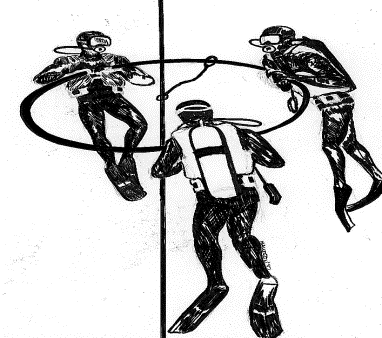
Of Hula Hoops and Buoyancy Control
by
Larry "Harris" Taylor, Ph.D.
This is an
electronic reprint of an article that appeared in NAUI NEWS (Nov/Dec. 1987, p.
35-36). This material is copyrighted and all rights retained by the author. This
article is made available as a service to the diving community by the author
and may be distributed for any non-commercial or Not-For-Profit use.
All rights reserved.
Go To: Home About "Harris" Articles Slides War Stories Editorials Links Fini
One of the most fundamental skills in
scuba diving is the ability to control buoyancy. Hovering at depth (forces of buoyancy and weight equal)
provides the sensation of weightlessness; the freedom of movement that
significantly contributes to that feeling of oneness of self and environment
that is the diver's high. In contrast, being either too light or too heavy means
that energy must be expended to stay at constant depth. This energy expenditure
leads to both frustration and exhaustion. The inability to control buoyancy
eliminates much of the fun for those who are just beginning to play in the
underwater world. Since most divers are too heavy, those divers who cannot
control their buoyancy usually end up on the bottom, generating silt and
destroying the visibility for all in the vicinity.
Most divers entering my 100-hour
Master Diving course have not yet fine-tuned the art of buoyancy control. I
utilize the exercise described below to allow divers to rapidly acquire the
ability to control their buoyancy. The exercise requires an anchor line (marked
at random intervals with duct tape), a hula-hoop, and a short piece of line with
two eye-splices (one around the hula hoop and one to go over the anchor
line).
Since most divers are initially
over-weighted, I prefer to establish "neutral buoyancy" (hovering) before the
exercise begins. Using their snorkels, I have the divers totally deflate their
b.c. and breathe in and out. In general, the diver should float at eye level and
rise and sink with the breathing cycle. Divers who sink are too heavy and must
remove weight. Divers who are too light will require weight to sink to eye
level.
The buoyancy control training
exercise is conducted in the following manner: The hula-hoop is first centered
on the anchor line, which is suspended in approximately 50 feet of water. The
students are instructed to hold the hula-hoop level at the chest and maintain
the hoop in a level position as they descend. Whenever a tape marker is
encountered, the students must hold position until given the signal to proceed.
The students then move the hoop down the line. Upon reaching the bottom, the
students must then ascend while holding the loop level. After two or three
complete trips, the students are then asked to move either up or down at the
whim of the instructor.

The Hula-Hoop Exercise
(Artwork by Maureen Reilly)
This exercise allows very rapid
acquisition of necessary buoyancy control skills and begins building a teamwork
approach to problem solving which is useful in any task oriented diving.
Go To: Home About "Harris" Articles Slides War Stories Editorials Links Fini
About The
Author:
Larry "Harris" Taylor, Ph.D. is a
biochemist and Diving Safety Coordinator at the University of Michigan. He has
authored more than 200 scuba related articles. His personal dive library (See
Alert Diver, Mar/Apr, 1997, p. 54) is considered one of the best recreational
sources of information In North America.
Copyright 2001-2024 by Larry "Harris" Taylor
All rights reserved.
Use of these articles for personal or organizational profit is specifically denied.
These
articles may be used for not-for-profit diving education